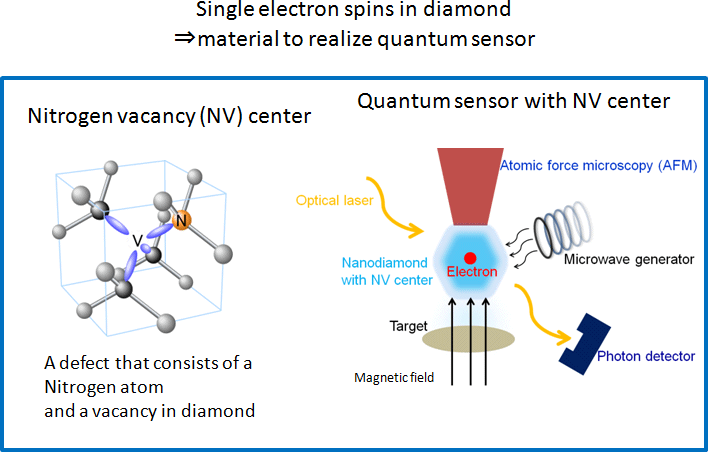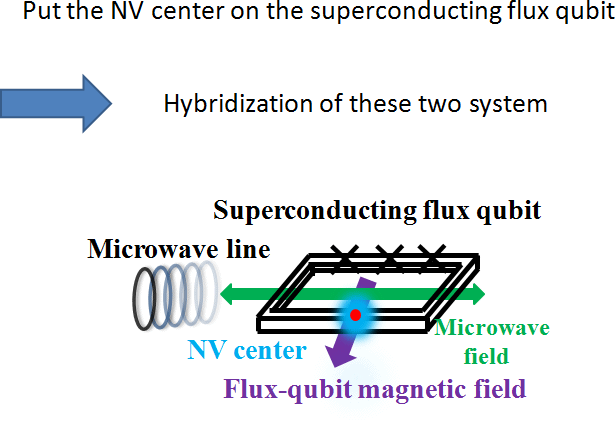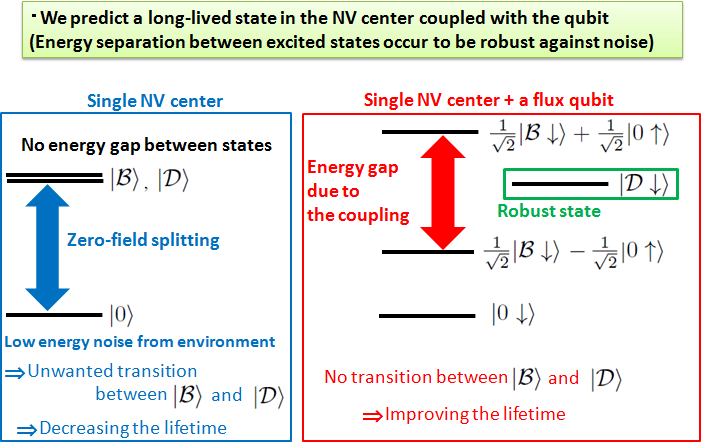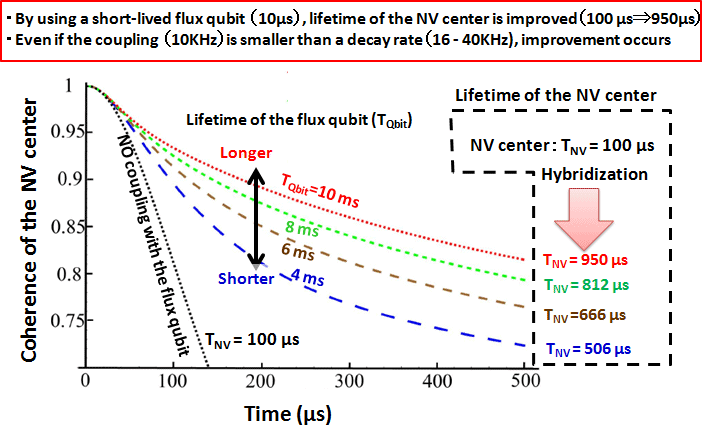Microsoft ends support for Internet Explorer on June 16, 2022.
We recommend using one of the browsers listed below.
- Microsoft Edge(Latest version)
- Mozilla Firefox(Latest version)
- Google Chrome(Latest version)
- Apple Safari(Latest version)
Please contact your browser provider for download and installation instructions.
March 23, 2015
Nippon Telegraph and Telephone Corporation
National Institute of Informatics
Osaka University
National Institute of Information and Communications Technology
Improving the lifetime of an electron spin in diamond for quantum sensing technology : Enhancing the sensitivity by an order of magnitude
Nippon Telegraph and Telephone corporation (NTT, Head office, Chiyoda-ku, Tokyo, Japan; Hiroo Unoura, President and CEO), in conjunction with its partners from the National Institute of Informatics (NII, Chiyoda-ku, Tokyo, Japan; Masaru Kitsuregawa, Director General), Osaka University (Suita, Osaka, Japan; Toshio Hirano, President), and National Institute of Information and Communications Technology (NICT, Headquarters, Koganei, Tokyo, Japan; Masao Sakauchi, President) show a way to improve the lifetime of single electron spins in diamond via a coupling with a superconducting flux qubit*1.
Since single electron spins in diamond*2 can be confined in a local area of tens of nanometers and can be coupled with magnetic fields and electric fields, it is expected that the electron spin can be used as a quantum sensor*3 to scan the structure of a material with nanometer scale features. By applying our results, the interaction time between the single electron spins and target fields can be increased so that the sensitivity will be improved. Moreover, if we could generate an entanglement between the electron spins, a quantum sensor with accuracy beyond the classical limit can be realized, which will make a contribution to the area of medical science and materials engineering. Our results will be published in Physical Review Letters on March 23.
This work was partly supported by the Funding Program for World-Leading Innovative R&D on Science and Technology (FIRST Program), JSPS KAKENHI Grant No. 25220601, and the Commissioned Research of NICT, "Research for Quantum Repeater Technology".
1.Background
Detection of weak magnetic fields, electric fields, and temperature of materials are key objectives in medical science and materials engineering, and this has many applications for practical purposes. For example, magnetic resonance imaging (MRI), which is frequently used in engineering, provides a way to obtain the three-dimensional information of materials via the detection of magnetic fields. Electroencephalogram is the recording of electric activity induced from the brain, and this also has an important role in medical science. To develop these fields, exploiting an improved sensor to detect a tiny signal in a smaller area with a high-accuracy is crucial.
Recently, the idea of a quantum sensor surpassing the accuracy and spatial resolution of present technology has gathered huge attention to by many researchers. Especially, single electron spins in diamond are known to have good controllability; for example a generation of a superposition by applying microwave pulses and readout via optical detection are possible with high fidelity (Fig.1). Such single electron spins can be confined in a nanometer-sized piece of diamond, making a device that can be used to detect a local region in the materials. However, the single electron spins are affected by noise and the lifetime*4 is decreased by the environment. This means that the sensitivity is worsened due to the limited interaction time with the target fields. Therefore, improving the lifetime is essential to realizing such a sensitive quantum sensor.
 Fig.1 Nitrogen Vacancy (NV) Center in diamond
Fig.1 Nitrogen Vacancy (NV) Center in diamond
NTT basic research laboratories, NII, Osaka University, and NICT succeeded in 2011 to couple a superconducting flux qubit and a spin ensemble in diamond. This is a crucial step to use this device for quantum computation where the superconducting flux qubit is used as a processor and the electron spins play a role of quantum memory. Moreover, since we can design the parameters of the superconducting flux qubit, this hybridization can be applied to obtain favorable properties in the electron spin in diamond.
2.Results of our research
NTT basic research laboratories, NII, NICT, and Osaka University firstly have found that it is possible to improve the lifetime of single electron spins in diamond via a coupling with a superconducting flux qubit (Fig.2). Although the lifetime of the superconducting flux qubit is ten times worse than that of the electron spin, such hybridization can actually enhance the lifetime of the single electron spins by an order of magnitude, which is highly counter-intuitive. This indicates that the accuracy of the sensor using the electron spins will be ten times better than that without the superconducting flux qubit, which will provide us with an ability to take a high-quality image of materials. The traditional way to improve the coherence time of the electron spins in diamond requires an active control of the electron spin where one has to apply microwave pulses to suppress the environmental noise. On the other hand, we show a completely new approach to improve the lifetime in a passive way, where the existence of the superconducting flux qubit alone can suppress the noise of the single electron spins in the diamond.
 Fig.2 Coupling between an NV center and a superconducting qubit
Fig.2 Coupling between an NV center and a superconducting qubit
Details of our theoretical proposal
- <1>By using a frequency tunable superconducting flux qubit, we tune the energy of the qubit to the energy of the single electron spins in the diamond.
- <2>By applying a microwave pulse along a specific direction of the diamond, we generate a superposition of the single electron spins.
- <3>After a certain time, we apply another microwave pulse along the same direction on the diamond and readout the spin state by using optical photons.
- <4>We simulate the experiment above, and predict that the single electron spins with the superconducting flux qubit in the diamond has a 10 times longer lifetime than the single electron spins without it.
3.Our advances in technology
The full analysis of the superconductor diamond hybrid system is very difficult, especially if we wish to consider the effect of noise. To overcome this problem, we developed a new theoretical model to analyze this system by using an appropriate approximation, and succeeded to simulate this system efficiently. Using our new theoretical prediction of this system, we found an improvement in the lifetime of the electron spin in diamond via the hybridization within this model.
(1)Mechanism to improve the lifetime of the electron spin in diamond via a coupling with the superconducting flux qubit (Fig.3)
 Fig.3 Mechanism to improve the coherence time of the NV center
Fig.3 Mechanism to improve the coherence time of the NV center
A defect that consists of a Nitrogen atom and a vacancy in diamond lattice is called a Nitrogen-Vacancy (NV) center, which has single electron spins (Fig.1). The NV center has two excited states in a ground-state manifold. It is known that, since these two excited states have almost the same energy, even a small perturbation from the environment can induce an unwanted transition between these two states, which decreases the lifetime of the NV center (Fig.3).
We have theoretically shown that a coupling with the superconducting flux qubit can energetically separate these two excited states in the NV center. One of the exited states in the NV center can be directly coupled with the superconducting flux qubit so that a finite energy shift occurs, while the other excited states cannot be affected by the superconducting qubit. This mechanism provides a protection of this system from low-energy noise induced by the environment, leading to an improvement in the lifetime of the NV center.
(2)Numerical simulation to estimate the lifetime of the NV center (Fig.4).
 Fig.4 Numerical simulation of the decay behavior of the NV center
Fig.4 Numerical simulation of the decay behavior of the NV center
We show that the coupling with the superconducting flux qubit can make the NV center robust against noise due to the energy separation between the excited states of the NV centers. We perform a numerical simulation of the dynamics of the NV center coupled with the superconducting flux qubit, and predict that the lifetime of the NV center, which is 100 micro seconds without the superconducting flux qubit, becomes 950 micro seconds after the hybridization with the superconducting flux qubit (Fig.4). This means that the accuracy of the NV center sensor becomes 10 times better than the sensor using the NV center alone.
Our research team has found that it is possible to improve the lifetime of the electron spin in diamond via a coupling with a superconducting flux qubit. Although the lifetime of the superconducting flux qubit is ten times worse than that of the electron spin, such hybridization can actually enhance the lifetime of the electron spin by an order of magnitude.
Also, it was believed that the coupling of the single NV center might be too weak to hybridize the superconducting flux qubit. However, we reveal that, even if this hybrid system is in a regime of a weak coupling*5, it is possible to observe the improvement of the lifetime of the NV center. So the necessary requirement to demonstrate our theoretical prediction is within a reach of the current technology.
It is difficult to simulate the superconductor diamond hybrid system, and a full analysis of this system is considered impossible even if we use the fastest existing computers, because of the large freedom of the environment to induce noise. We have experimentally succeeded to hybridize a superconducting flux qubit and an ensemble of NV centers, we are familiar with the analysis of this system. We generalize our previous model to describe the ensemble of NV centers coupled with the superconducting flux qubit to a new model to describe a single NV center coupled with it. Especially, we simplify the environmental effect on this hybrid system and so succeed in simulating this system using an ordinary desktop computer. This advantage led us to obtain the results described here.
4.Perspective
Next, we will try an experiment to couple a single NV center with a superconducting flux qubit. Also, we will tackle the research of quantum sensing technology using this hybrid system. Especially, the future target of our research is to generate an entanglement between NV centers in nanometer sized piece of diamond. We will attempt to realize a quantum entanglement sensor and to beat classical sensors. If such a sensor is realized, it will be possible to detect magnetic fields, electric fields, and temperature in a nano-meter region with high accuracy. This provides us a way to readout human brain activity, and possibly we can target the location of tumors before the surgery. Also, such a sensor will allow us to take a three-dimensional image of nano-materials, which could be useful in the characterization of the design of new materials.
Publication information
Yuichiro Matsuzaki, Xiaobo Zhu, Kosuke Kakuyanagi, Hiraku Toida, Takaaki Shimo-Oka, Norikazu Mizuochi, Kae Nemoto, Kouichi Semba, William J. Munro, Hiroshi Yamaguchi, and Shiro Saito,
"Improving the coherence time of a quantum system via a coupling to a short-lived system"
Physical Review Letters(2015)
Glossary
*1superconducting flux qubit
This is a device to store quantum information by a persistent current flowing along a superconducting circuit. The direction of the current corresponds to a bit of information, and a distinct property of this device is a capability to make a superposition of a left-handed current and a right-handed current, which is essential to perform quantum computation.
*2single electron spins in diamond
The defects in diamond are called NV centers, which consists of a Nitrogen atoms and a lattice vacancy, as shown in Fig.1. This provides single electron spins inside the structure. The energy of the NV center is close to the energy of the superconducting flux qubit, which is a favorable property to hybridize them.
*3Quantum sensor
This is a sensor to use quantum properties such as a superposition and entanglement to achieve sensitivity beyond a classical limit.
*4Lifetime
It is possible to make a superposition between the spin up state and spin down state with the NV center, which is useful for the quantum sensor. However, such superposition is fragile against noise, and we define the typical time scale to keep the superposition as a lifetime.
*5Weak coupling regime.
When two systems are coupled, the ratio between the coupling strength and the decay rate of the system is commonly used as a measure of how strongly they can be coupled. If the decay rate of the system is larger than the coupling strength, the system is considered as in a regime of a weak coupling.
Press Contact
Nippon Telegraph and Telephone Corporation
Science and Core Technology Laboratory Group, Public Relations
a-info@lab.ntt.co.jp
Research Organization of Information and Systems
National Institute of Informatics
Publicity Team
kouhou@nii.ac.jp
Osaka University
Graduate School of Engineering Science
General Affairs Section
ki-syomu@office.osaka-u.ac.jp
National Institute of Information and Communications Technology
Public Relations Department
publicity@nict.go.jp
Information is current as of the date of issue of the individual press release.
Please be advised that information may be outdated after that point.
NTT STORY
WEB media that thinks about the future with NTT











